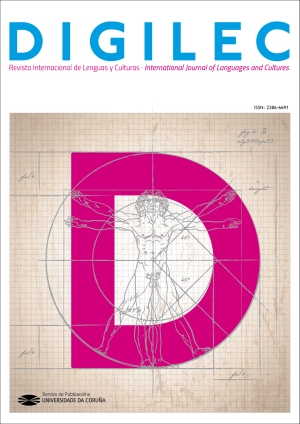On the feet of the elephants. The importance of Terry Pratchett’s footnotes for building the Discworld
Main Article Content
Abstract
Terry Pratchett’s Discworld book series is a wide narrative display that builds a universe through more than fifty novels. Nevertheless. due to its division into different storylines, it is possible to choose between several doors to start reading it. Footnotes are the mark of distinction of the author, who, besides employing them to make clarifications and remarks, relies on them to broaden the narrative base of the world he builds. With these resources, Pratchett gives the reader more information about the Discworld’s lore, from the basis and genesis, as the Turtle Great A’Tuin with her elephants holding the Disc, to the practical and organizational issues of the cities, such as Ankh-Morpork’s guilds. Furthermore, it also includes a significant number of easter eggs and references to our reality, with a well-managed balance between criticism and humor. The notes work as a tool that helps to highlight those allusions in order to preserve the parodical and satirical aspects of the text in the case that the reader is not familiar with some of the works and details included. Thus, through these notes, a person who is starting with the author’s work can, during its first encounter, reach a significant level of understanding of the complex narrative universe created by Pratchett.
Keywords:
Downloads
Article Details
References
Aristófanes. (2006). Las Nubes. Cátedra.
Benstock, S. (1983). At the Margin of Discourse: Footnotes in the Fictional Text. PMLA, 98(2), 204–225. https://doi.org/10.2307/462046
Briggs, S., & Pratchett, T. (2001). Nanny Ogg's Cookbook: A Useful and Improving Almanack of Information including Astonishing Recipes from Terry Pratchett's Discworld. Transworld.
Genette, G. (1987). Seuils. Seuil.
Genette, G. (1997). Paratexts: thresholds of interpretation. Cambridge University Press.
Haberkorn, G. (2018). Seriously Relevant: Parody, Pastiche and Satire in Terry Pratchett’s Discworld Novels. In: Rana, M. (eds) Terry Pratchett's Narrative Worlds. Critical Approaches to Children's Literature (pp. 137-157). Palgrave Macmillan. https://doi.org/10.1007/978-3-319-67298-4_8
Hoel, C. (2008). The Ludic Parody of Terry Pratchett. FORUM: University of Edinburgh Postgraduate Journal of Culture and the Arts, Special 02. https://doi.org/10.2218/forum.0.598
Leroux, G. (1909-1910). Le Fantôme de l'Opera. Le Gaulois.
Löfgren, J. (2017). ‘It’s a Good Job Nobody Mentioned Hedgehogs’: The Use of Narratives in Discworld Fandom. Folklore, 128, 75-92.
Luthi, Daniel (2014). Toying with Fantasy: The Postmodern Playground of Terry Pratchett's Discworld Novels. Mythlore: A Journal of J.R.R. Tolkien, C.S. Lewis, Charles Williams, and Mythopoeic Literature, 33(1), Article 8.
Maloney, E. J. (2005). Footnotes in fiction: a rhetorical approach [Doctoral dissertation, Ohio State University]. OhioLINK Electronic Theses and Dissertations Center. http://rave.ohiolink.edu/etdc/view?acc_num=osu1125378621
Martin, E. (2020). For the Love of Footnotes: When Fantasy Gets Extra Nerdy. Tor.com. https://www.tor.com/2020/03/18/for-the-love-of-footnotes-when-fantasy-gets-extra-nerdy/
Ovidio. (2005). Las Metamorfosis. Cátedra.
Pollard, A. (1970). Satire. Methuen.
Pratchett, T. (1983). The Colour of Magic. Colin Smythe.
Pratchett, T. (1987). Mort. Gollancz.
Pratchett, T. (1988). Wyrd Sisters. Gollancz.
Pratchett, T. (1989). Guards! Guards!. Gollancz.
Pratchett, T. (1991). Witches Abroad. Gollancz.
Pratchett, T. (1992). Lords and Ladies. Gollancz.
Pratchett, T., & Simpson, J. (2008). The Folklore of Discworld: Legends, myths and customs from the Discworld with helpful hints from planet Earth. Doubleday.
Scholz, T. (2018). Where Discourse Meets Discworld: Labyrinths, Humour and the Neo-Baroque in Terry Pratchett’s Discworld Stories. In: Rana, M. (eds) Terry Pratchett's Narrative Worlds. Critical Approaches to Children's Literature (pp. 227-245). Palgrave Macmillan. https://doi.org/10.1007/978-3-319-67298-4_13


